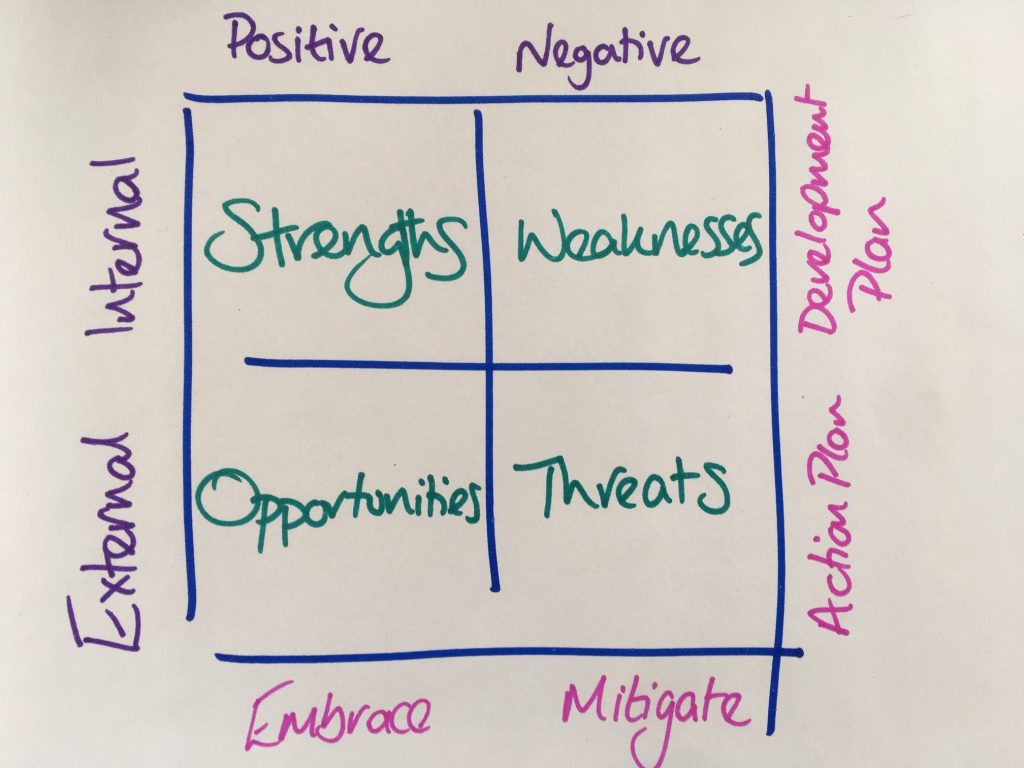No, not a teacher’s pet, always compliments the boss, gets work in ahead of time kind of swot. The title is, of course, a play on words which perhaps not everyone will get – I am reliably informed by my teenage daughter that NO-ONE says this anymore…! Today’s blog is in fact to share a super simple framework with you.
Many of you will have heard of SWOT analysis, particularly in relation to analysing projects, and may have used it. I often find though, when I introduce it to colleagues in coaching or workshops, that few remember to use it for a variety of contexts, not least personal. It is a tool, a framework, to help you evaluate any particular situation, by exploring the Strengths, Weaknesses, Opportunities and Threats (hence SWOT)
Its flexibility is one of the elements that I like – it can be used to think about a project, a service, a team or to apply to yourself. I would certainly encourage everyone to undertake a personal SWOT as part of your planning for any development review you are undertaking for yourself. For me this normally happens in January, when I have the post-Christmas blues and feel the need to re-evaluate my career and personal set up and create resolutions for my learning.
But it is equally beneficial for a team, taking the time together to reflect on these four elements – to help reinforce what is going well and feel resilient and resourceful to move forward.
Its a simple 4 box grid – one box labelled for Strengths, Weaknesses, Opportunities and Threats. Draw yourself an empty one now. Then in each box respond to the word. For example, if you are thinking about yourself:
- Strengths: what are you good at; what do you enjoy contributing to; what gets you out of bed in the morning; what tasks use your skills most effectively; what positive feedback have you received.
- Weaknesses: what are your knowledge and skills gaps; what situations could you handle better; what tasks do you find more challenging; what do you enjoy less; how might your critics describe you.
- Opportunities: what positive changes are on the horizon; what excites you about the future; how could you raise your profile; how might you position yourself.
- Threats: What future events might put you at a disadvantage; what might test your resourcefulness; how do you keep up to date with professional challenges and changes; what obstacles might you encounter.

As you can see from the sketch above, the strengths and weaknesses refer to internal factors – in this case you! Opportunities and threats are external, i.e. the context within which you work or live.
Respond to the internal factors through focussing on your personal development: embracing and celebrating your strengths, and minimising the impact of weaknesses through a development plan.
Respond to the external factors by taking actions that take advantage of opportunities and mitigate for the impact of threats.
SWOT is so simple to use as part of your personal development that it is often overlooked. Certainly it won’t lead you into any answers or give you clarity on its own, but it is a great place to start. Follow up with conversations – with your manager or colleagues, mentor or friends; to develop greater insight.
Juliet Flynn, Organisational and People Development
 People, Culture and Inclusion
People, Culture and Inclusion Juliet Flynn
Juliet Flynn 163
163


